Wedding Mehndi Designs For Hands Biography
Wedding Mehendi - Its a symbol for suhagan.
Mehndi (Urdu: مہندی), the Henna ceremony, or the Rasm-e-henna ceremony, typically takes place one or two days prior to the main wedding day. The event is traditionally held separately for the bride and the groom The henna is symbolically placed on the couple's hands. The groom's friends and family bring along sweets and henna for the bride, and the bride's family does the same for the groom. On the bride's ceremony, the groom normally does not participate and similarly, on the groom's event the bride stays at home. Female guests are sometimes offered mehndi at the host's discretion.
Traditionally, since there were separate functions for both the bride and the groom, the groom's function was called 'Tael' (oil) where female guests put some oil into the groom's hair. With the ceremony now held simultaneously for both the groom and the bride, the use of the term 'tael' has diminished greatly. In some cases, the entire ceremony is instead referred to as "Tael Mehndi" (Oil and Henna) ceremony
In India, Wedding is not completed without mehndi Desings on bride hands. Any bride belongs to any part of india she will not called as bride if any mehndi patterns are not drawn on her hands.Beauty parlours have special rates and price for bride -Now a days brides have a choice between indian mehndi designs and arabic mehndi designs. The cost of mehndi artist vary from parlour to parlour( depend which pattern is drawn on hands)
Pakistani marriage is consistently accepted as the happiest and funniest. In marriage division anybody wants to attending altered and different. In this three day accident conceivably Mehndi action is a lot of agitative day for girls as able-bodied as for brides. You charge to abrasion lot of appropriate on this appropriate event. There are abounding girls including cousins, sisters from both ancillary helpmate and groomThe bride normally wears a green dress or yellows/orange for the Henna celebration and uses only light, or mostly, no make-up. The groom will typically wear a casual Shalwar Qameez. The bride and/or the groom are brought forward in the ceremony under a decorative dupatta by their close relatives. In the bridal ceremony, a certain number of married women who are closely related to the bride apply henna to her hands, and feed her sweets. This ritual is supposed to bring good luck and longevity to the bride's married life. Similarly, on the groom's side, oil is applied to his head and sweets are fed to the groom.
A song competition also occurs in the Rasme Henna or Mehndi celebrations between the bride and groom's side. Young women and men will sing teasing songs about the other side (where the bride's side pokes good natured fun at the groom's side and vice versa) and try to compete in this ritual sing song. Sometimes elaborate musical and acting performances are part of the Mehndi celebrations. Elaborate dance sequences and competitions between the bride and groom's families are also quite common these days
.
Traditionally, the Mehendi was considered a women's event and men did not participate in it. The sing song etc. was left almost entirely to women. However, this has changed substantially in recent times with males featuring prominently in the Mehndi celebrations as well. A recent trend gaining popularity is to announce a colour theme for the mehendi whereby guests are supposed to dress up in a particular colour. Commonly used colours are bright reds, oranges and yellows.
. Wedding Mehndi Designs For Hands





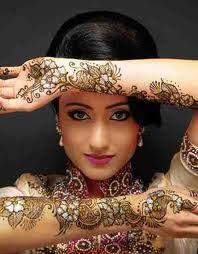

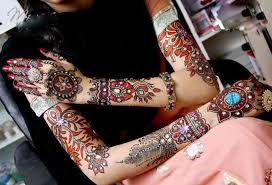

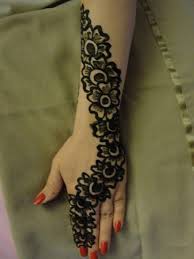
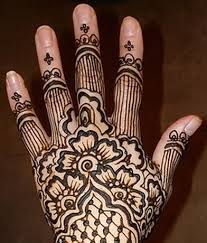
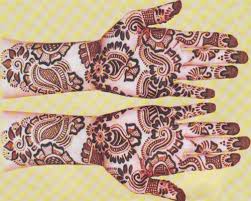
Wedding Mehendi - Its a symbol for suhagan.
Mehndi (Urdu: مہندی), the Henna ceremony, or the Rasm-e-henna ceremony, typically takes place one or two days prior to the main wedding day. The event is traditionally held separately for the bride and the groom The henna is symbolically placed on the couple's hands. The groom's friends and family bring along sweets and henna for the bride, and the bride's family does the same for the groom. On the bride's ceremony, the groom normally does not participate and similarly, on the groom's event the bride stays at home. Female guests are sometimes offered mehndi at the host's discretion.
Traditionally, since there were separate functions for both the bride and the groom, the groom's function was called 'Tael' (oil) where female guests put some oil into the groom's hair. With the ceremony now held simultaneously for both the groom and the bride, the use of the term 'tael' has diminished greatly. In some cases, the entire ceremony is instead referred to as "Tael Mehndi" (Oil and Henna) ceremony
In India, Wedding is not completed without mehndi Desings on bride hands. Any bride belongs to any part of india she will not called as bride if any mehndi patterns are not drawn on her hands.Beauty parlours have special rates and price for bride -Now a days brides have a choice between indian mehndi designs and arabic mehndi designs. The cost of mehndi artist vary from parlour to parlour( depend which pattern is drawn on hands)
Pakistani marriage is consistently accepted as the happiest and funniest. In marriage division anybody wants to attending altered and different. In this three day accident conceivably Mehndi action is a lot of agitative day for girls as able-bodied as for brides. You charge to abrasion lot of appropriate on this appropriate event. There are abounding girls including cousins, sisters from both ancillary helpmate and groomThe bride normally wears a green dress or yellows/orange for the Henna celebration and uses only light, or mostly, no make-up. The groom will typically wear a casual Shalwar Qameez. The bride and/or the groom are brought forward in the ceremony under a decorative dupatta by their close relatives. In the bridal ceremony, a certain number of married women who are closely related to the bride apply henna to her hands, and feed her sweets. This ritual is supposed to bring good luck and longevity to the bride's married life. Similarly, on the groom's side, oil is applied to his head and sweets are fed to the groom.
A song competition also occurs in the Rasme Henna or Mehndi celebrations between the bride and groom's side. Young women and men will sing teasing songs about the other side (where the bride's side pokes good natured fun at the groom's side and vice versa) and try to compete in this ritual sing song. Sometimes elaborate musical and acting performances are part of the Mehndi celebrations. Elaborate dance sequences and competitions between the bride and groom's families are also quite common these days
.
Traditionally, the Mehendi was considered a women's event and men did not participate in it. The sing song etc. was left almost entirely to women. However, this has changed substantially in recent times with males featuring prominently in the Mehndi celebrations as well. A recent trend gaining popularity is to announce a colour theme for the mehendi whereby guests are supposed to dress up in a particular colour. Commonly used colours are bright reds, oranges and yellows.
. Wedding Mehndi Designs For Hands
Wedding Mehndi Designs For Hands
Wedding Mehndi Designs For Hands
Wedding Mehndi Designs For Hands
Wedding Mehndi Designs For Hands
Wedding Mehndi Designs For Hands
Wedding Mehndi Designs For Hands
Wedding Mehndi Designs For Hands
Wedding Mehndi Designs For Hands
Wedding Mehndi Designs For Hands
Wedding Mehndi Designs For Hands
Wedding Mehndi Designs For Hands
Wedding mehndi Designs For Hands
Simple Mehndi Designs Indian Bridal Arabic 2011
Ladies Special - Mehndi Designs On Hands
Bridal Mehndi Henna Design 14 June 2009
No comments:
Post a Comment